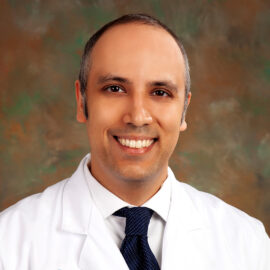UofL Health is proud to have dedicated specialists to diagnose and treat disorders of the valves, walls and chambers of the heart. This revolutionary new field is known as Structural Heart and Valve Cardiology. The University of Louisville and UofL Health have been pioneers in this field for many years.
Our specialists employ minimally invasive techniques, that do not require traditional surgery, to replace and repair heart valves and structures of the heart.
Procedures and treatments we offer:
- Transcatheter aortic valve replacement (TAVR)
- Transcatheter edge-to-edge mitral valve repair with MitraClip (Mitral Clip)
- Transcatheter mitral valve replacement (TMVR)
- Transcatheter PFO/ASD closure
- Watchman Device left atrial appendage closure
Conditions treated:
- Aortic valve stenosis and regurgitation
- Mitral valve stenosis and regurgitation
- Heart murmurs
- Valvular heart disease
- Patent Foramen Ovales (PFO)
- Atrial Septal Defects (ASD)
- Cryptogenic strokes
- Bleeding with anticoagulation (“blood thinners”) for atrial fibrillation
Transcatheter aortic valve replacement (TAVR)
TAVR is a minimally invasive procedure to replace the diseased aortic valve of a patient due to aortic valve stenosis. The stent valve is typically inserted through the femoral artery percutaneously (and insertion technique through the skin).
Transcatheter edge-to-edge mitral valve repair with MitraClip (Mitral Clip)
Mitral Clip is a minimally invasive procedure to repair a leaking mitral valve. The Mitral Clip is placed into the body through the vein in the leg and attaches to the two parts (“leaflets”) of the mitral valve and brings them closer together to reduce the leakage.
Transcatheter PFO/ASD closure
Some people may suffer from strokes related to a small hole (a PFO or ASD) between the top two chambers of the heart. The small hole can be closed with a plug and reduce the incidences of future strokes in some people. Our structural cardiologists work closely with neurologists ("brain doctors") to identify people that may benefit from closure of the small holes in the heart.
Watchman Device left atrial appendage closure
Some people who take anticoagulation ("blood thinners") to reduce the risk of stroke from atrial fibrillation may not be able to tolerate these medicines and can develop life threatening bleeding. Our Structural Cardiologists work hand-in-hand with Electrophysiologists (heart rhythm doctors) to determine which patients may benefit from a Watchman device in order to get them off of blood thinners and still protect them from strokes.
Providers

Faraaz Rahman, M.D.
Structural Heart and Valve Cardiologist
UofL Physicians – Cardiology
502-588-7010


